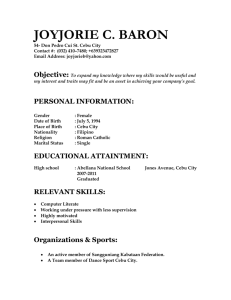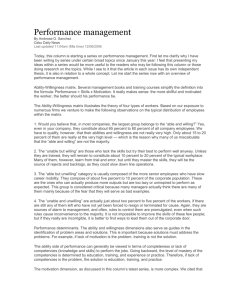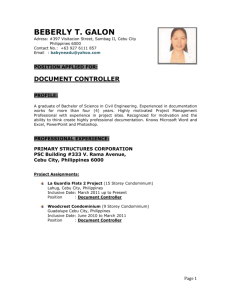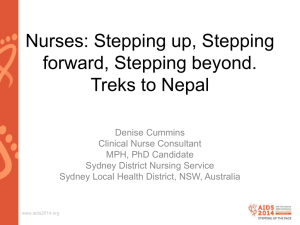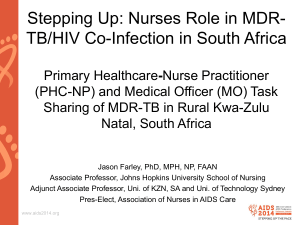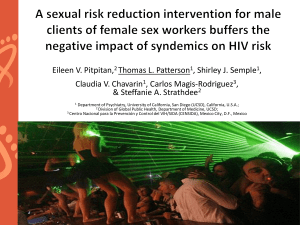Powerpoint - AIDS 2014 - Programme-at-a
advertisement
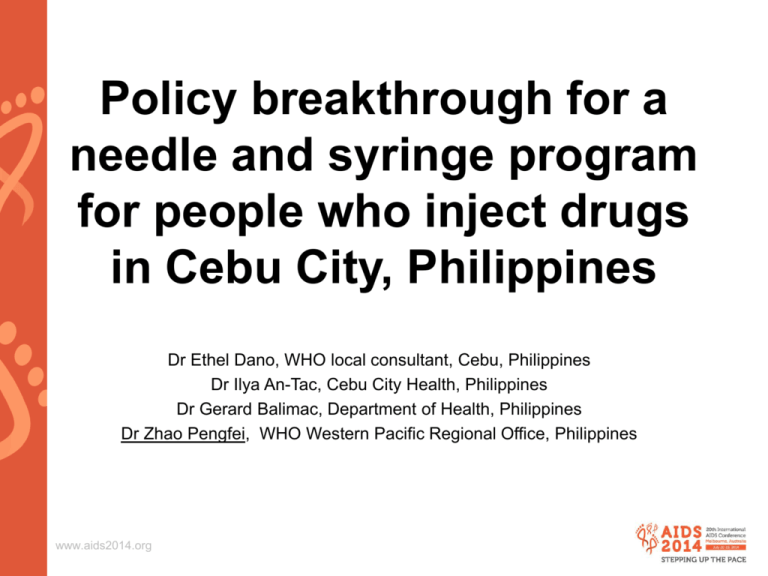
Policy breakthrough for a needle and syringe program for people who inject drugs in Cebu City, Philippines Dr Ethel Dano, WHO local consultant, Cebu, Philippines Dr Ilya An-Tac, Cebu City Health, Philippines Dr Gerard Balimac, Department of Health, Philippines Dr Zhao Pengfei, WHO Western Pacific Regional Office, Philippines www.aids2014.org Outline 1. 2. 3. 4. The HIV epidemic in the Philippines Advocacy and technical assistance Summary of lessons learned The way forward www.aids2014.org Every 2 hrs a Filipino becomes HIV infected… 2000 1 1 new cases in 3 days 2012 9 new cases a day or 1 new case every 3 hours 2013 13 new cases a day www.aids2014.org As of June 2013, Philippine HIV Registry – NEC/DOH Quick glance at HIV in the Philippines • Population: 92.34M (NSO 2010) • Projected number of people living with HIV (15-49) by 2014: 32,279 • Reported cases since 1984: 16,516 • • HIV cases (15,009) AIDS cases (1,507) Manila • Reported AIDS deaths: 887 89%first menreported Filipino HIV case in the Philippines The InMode 1984ofistransmission a heterosexual male OFW. • 93% sexual (73% among MSM) • 4% needle/syringe sharing among PWID HIV Data prevalence < 1% among general population HIV Sources: Philippine HIV/AIDS Registry (asepidemics of December 2013) Cities with concentrated among MSM, PWID Philippine Integrated HIV City) Behavioral & Serological Surveillance and FFSW (eg. Cebu Cebu EPP/Spectrum, UNAIDS Software MSM = men who have sex with men, PWID = people who inject drugs, FFSW = female freelance sex workers www.aids2014.org HIV Data Sources: Philippine HIV/AIDS Registry (as of December 2013), and Philippine Integrated HIV Behavioral & Serological Surveillance EPP/Spectrum, UNAIDS Software Quick facts about PWID in Metro Cebu Metropolitan Cebu # of PWID (2011 estimate) Cebu city 2,017 Other cities 3,983 Total 6,000 Median age of respondents (n=767)* 30 yrs (15-56) Age of first drug use (Median) 16 yrs Age of first Injection (Median) 19 yrs % injecting nalbuphine 98% Average number of injections/day 3 (1-12) % PWID tested and 6% Source: DOHstatus NEC IHBSSin 2013 knew their HIV last year www.aids2014.org PWID = people who inject drugs * Data source: IHBSS survey 2013 A public health crisis in Cebu, Philippines (HIV) 60% 53.2% 52.3% 50% HIV Prevalence 42.3% 40% 30.4% 30% Cebu (male) Cebu (female) Mandaue 20% 10% 0% 0.8% 2005 0.4% 0.6% 2007 2009 Year 3.6% 2011 2013 HIV Data Sources: Philippine HIV/AIDS Registry (as of December 2013), Philippine Integrated HIV Behavioral and www.aids2014.org Serological Surveillance EPP/Spectrum, UNAIDS Software A public health crisis in Cebu, Philippines (Hepatitis C) 100% 88.0% 95.0% Hepatitis C prevalence 90% 80% 92.8% 80.8% 70% 60% GEN SANTOS 50% ZAMBOANG A 40% 30% 20% 10% 0% 6.3% 4.8% 4.1% 3.7% 0.0% 0.0% 0.0% 2007 2009 2011 0.3% 2005 Data Sources: Philippine Integrated HIV Behavioral & Serological Surveillance EPP/Spectrum, UNAIDS Software, 2005-2011 www.aids2014.org Delay in response due to conflicting laws The Philippines AIDS Prevention and Control Act of 1998 (RA8504) Dangerous Drug Act of 2002 (RA9165) • Support HIV response in sex workers and people who inject drugs • Access to HIV prevention • Improving quality of life • Impedes HIV response: – Arrest • Mere possession of needles as injecting paraphernalia (even without drugs) • Caught visiting area known to be drug dens – Problem for peer educators bringing clean needles/ syringes to the community www.aids2014.org Delay in response due to ‘Chicken and Egg’ situation • Central level expects local government to take initiative in harm reduction, and policy making based on local experience • Local government waits for clear health policy guidance from central government, before action is taken www.aids2014.org Advocacy & technical assistance to set up NSP in Cebu • Development of advocacy briefing paper – Fact finding – Packaging HIV epi data for stakeholders • Share international harm reduction experiences • Advocacy meetings including training of police • Drafting proposal for community-based pilot of harm reduction programme www.aids2014.org NSP = needle and syringe programme Advocacy works… good work continues… • Drug use is a multiple health problem, PWID should NOT be seen as criminals • Access to essential health commodities (condoms, needles/syringes) is a human right • A public health approach (harm reduction) improves public security PWID = people who inject drugs www.aids2014.org Quotes from a catholic Brother P. - religious group speaking at police training workshop “Love is above law!” “Asking permission is difficult, but asking forgiveness is easy” If a Catholic Brother can do (distributing needles/syringes and condoms) for the sake of saving lives, who else cannot? www.aids2014.org Consensus among key stakeholders Finding a local solution for a local problem www.aids2014.org ‘One-stop shop’ comprehensive harm reduction in Cebu social hygiene clinic 1. 2. 3. 4. 5. 6. 7. 8. 9. Needle and syringe program HIV counseling and testing Antiretroviral therapy Management of sexually transmitted infections Condom programme for PWID and their partners Targeted information, education, communication and psychosocial services for PWID and their partners Vaccinations, diagnosis and treatment of Viral Hepatitis Prevention, diagnosis and treatment of TB* Referral for voluntary rehabilitation www.aids2014.org Number of PWID accessing needles/ syringes in Cebu social hygiene clinic (2013-2014) 700 Restriction on # of distribution per visit 650 600 526 Number of PWID 500 460 410 406 400 321 348 372 379 404 2013 2014 331 321 2 per. Mov. Avg. (2013) 300 2 per. Mov. Avg. (2014) 233 234 200 137 100 43 54 62 JAN FEB MAR APR # Needles/syringes per PWID distributed 2013: 115 2014 (as of Jun) 87 0 MAY JUN JUL AUG SEPT OCT www.aids2014.org Source of dada: Cebu social hygiene clinic-progress report, 2014 NOV DEC Month PWID = people who inject drugs Lessons learned… so far • Social hygiene clinic based NSP - a model fits well the Philippines • Dedicated manager/staff essential, and more trained staff in demand to ensure quality of services and use of data • Strong support from DoH, PWID community, NGOs from HIV-positive groups and faith-based organizations • WHO local consultant provides direct support and facilitates additional assistance in time • Working with police possible! Increased police understanding of public health solution to HIV crisis as public security www.aids2014.org DoH = Department of Health NSP = needle and syringe programme The way forward • Continue advocacy to enforcement agencies (including city lawyers) to sustain the local enabling environment, with a vision to reform the drug policy/laws • Strengthen and monitor current programme to ensuring the quality of services and use of data • Extend the current facility-based services to community-based • Replicate Cebu model to other cities which have HIV among PWID (e.g. under the GF new funding model) www.aids2014.org Acknowledgements • • • • • • • • Jerson See, Cebu Plus Association, the Philippines Mark Arnejo, Cebu Plus Association Floyd'Maldepena, Cebu Plus Association Daisy Villa, Cebu City Health Department Teresita Rodriguez, Cebu City Health Department Gary Reid, Independent consultant Nerissa Dominquez, WHO Philippines Ying-Ru Lo, WHO Western Pacific Regional Office www.aids2014.org Thank you! Is there any existing experience on Nalbuphine substitution treatment? What about Buprenorphine? Terumo Insulin Syringes - 29G U-100 1 cc 1/2" - BX 100 www.aids2014.org
